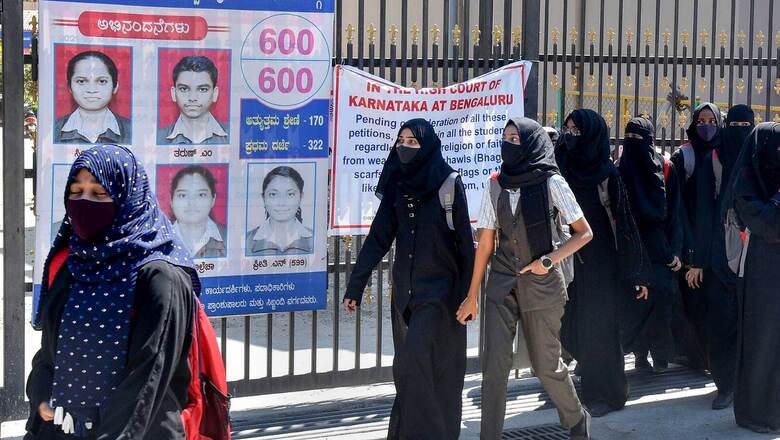
views
The Karnataka High Court verdict in the Hijab controversy was easily predictable as the law on such issues has evolved and is clear since the past couple of decades.
The judgments in controversies such as Tandava dance, Triple Talaq, entry of women in temples have laid strong precedents and clarified the law on the point of reasonable restrictions on religious freedom on various grounds including public order, health and morality.
In the Hijab verdict too, the Karnataka High Court clarified that Freedom of Religion is not absolute and is subject to reasonable restrictions and what is not an essential religious practice will have to give precedence to elements of public order, morality and health among other things.
Freedom of Religion – Not an Absolute Right
India is a secular but not an anti-religious state, for Article 25 of the Indian Constitution guarantees the freedom of conscience and religion, subject to certain limitations. Thus, unlike the American and the Australian constitution where Freedom of Religion is an absolute right, and the judiciary there had to work overtime to develop reasonable restrictions or in other words exceptions, the Indian Constitution is a step ahead in this aspect.
The limitations on the freedom of religion in the Indian Constitution are explicit and are not a result of judicial interpretation.
Thus, in the Hijab controversy wherein the reasonable restriction of imposing rules related to academic institutional dress code or uniform clashed with the practice of using hijab, the High Court ruled in favour of reasonable restriction.
ALSO READ | Southern Slice: A Tale of Two Dreams That Lifts the Veil on the Hijab Controversy
The Precedent
In the landmark Ananda Margis case in 1984, the judiciary held that the Tandava dance by people carrying daggers, trishuls and skulls is ultra vires to the elements of public order, morality and health, and therefore was prohibited.
In Shayara Bano Vs the Union of India (2017) case, the Supreme court held that the centuries-old practice of Triple Talaq was unconstitutional and therefore illegal.
While deciding such controversies, the judiciary has tested the ingredients of the claims not just in context to the fundamental rights of the stakeholders, but also evaluated if a particular subject or practice is essential to a particular religion. Thus, in the current controversy, the judiciary evaluated whether or not the use of Hijab is an essential religious practice.
Essential Religious Practice Doctrine
In 1994, a five-judge bench of the Supreme Court held that a mosque was not an “essential part of the practice of the religion of Islam” and hence its acquisition by the State is not prohibited under the provisions of the Constitution of India.
It is interesting to note that religion is nowhere defined in the Constitution of India. Furthermore, the doctrine of essential religious practices was evolved while testing certain Hindu religious practices against constitutional provisions. It was observed by the judiciary that what constitutes the essential part of a religion is primarily to be ascertained with reference to the doctrines of that religion itself. Under Article 26, the religious denominations and organisations have complete autonomy to decide what rites and acts are essential according to the tenets of the religion they observe, and no outside entity has any authority to interfere in such decisions.
There is no clarity on what constitutes essential religious practice in the Constitution of India. Therefore, the Indian judiciary has the responsibility to ascertain the different aspects of essentiality. Thus, even if the court is convinced that a particular practice is essentially religious, it goes on to determine whether the practice is essential to religion — a practice shall be considered essential if without it, a religion shall not remain religion.
In current times, only if the test of essential religious practice is crossed, courts proceed to test the controversy in the context of restrictions and rights stated in Articles 25 and 26.
Narrowing the Scope of Religious Freedom?
In the Hijab controversy, the High Court noted that the use of Hijab is not an essential religious practice of Islam. Some sections of society are of the view that the application of the doctrine of essential religious practices over several years has apparently narrowed the scope of freedom of religion in India. But they tend to forget that the Indian Constitution has otherwise also placed reasonable restrictions and stated that freedom of religion is not absolute. The judiciary is only clarifying what the Constitution permits.
Appeal in Supreme Court
Now that it is already decided that the use of Hijab is not an essential religious practice, the appeal in the Supreme Court may also want to invoke the fundamental rights of equality and freedom of expression and choice.
Be it the Ayodhya Temple, the Sabarimala issue or mosque not being an essential part of Islam, religion-based controversies reaching the doors of the Supreme Court is not a healthy sign, that too seven decades after Indian Constitution came into existence.
Whatever be the outcome of the appeal in the Supreme Court, it will undoubtedly lead to immense drain on precious judicial time and resources.
The author is advocate, Bombay High Court and founder of the legal firm Satya Muley & Co. The views expressed in this article are those of the author and do not represent the stand of this publication.
Read all the Latest Opinion News and Breaking News here
















Comments
0 comment